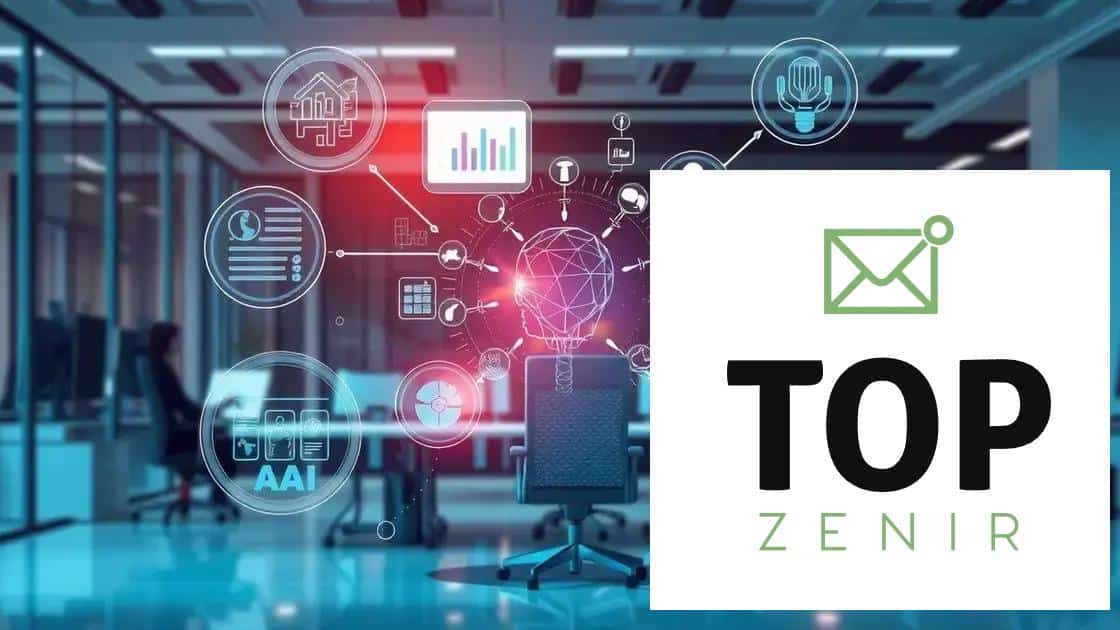Invisible AI enters mainstream enterprise use

Invisible AI refers to systems that enhance business operations seamlessly in the background, boosting efficiency and customer experiences while addressing challenges like data privacy and integration complexities.
Invisible AI enters mainstream enterprise use and is reshaping industries. Have you noticed how technology quietly enhances operations? Let’s dive deep into its influence.
Understanding invisible AI technology
Understanding invisible AI technology can help businesses transform how they operate. This technology enhances processes without being intrusive. It’s about making tasks easier and more efficient, often with minimal user interaction.
What is Invisible AI?
Invisible AI refers to systems designed to assist users without overt acknowledgment of their presence. Examples include chatbots that offer support while you focus on your work or algorithms that optimize workflows in the background. This seamless integration can boost productivity and improve user experience.
Benefits of Invisible AI
Adopting invisible AI brings numerous advantages to organizations. Consider the following:
- Improved efficiency in operations.
- Reduced workload on employees.
- Enhanced decision-making with real-time data.
- Better customer experiences through tailored interactions.
By embedding AI systems into everyday tasks, companies can gain insights without the need for complex data analysis. For instance, an AI-driven tool can analyze customer interactions and suggest improvements based on trends it identifies.
Challenges in Implementing Invisible AI
While the benefits are significant, businesses may face challenges when integrating this technology. Concerns regarding privacy, data security, and the need for effective training are paramount. It’s essential to address these issues to maximize the potential of invisible AI.
Companies must also ensure that their employees understand how to interact with these systems effectively. This knowledge helps them leverage AI’s full capabilities. Additionally, businesses should consider regulatory aspects related to data protection.
Ultimately, understanding invisible AI technology allows organizations to make informed choices about its implementation. By recognizing the benefits and challenges, businesses can better position themselves in a rapidly evolving tech landscape. Embracing this technology isn’t just a trend; it is a step toward future-proofing operations.
Impact of invisible AI on businesses

The impact of invisible AI on businesses is profound and transformative. This technology often operates in the background, enhancing processes without disrupting daily activities. By streamlining workflows, invisible AI allows companies to focus on their core tasks while improving overall efficiency.
Enhanced Decision-Making
One significant benefit of invisible AI is its ability to provide insights from vast amounts of data. Organizations can analyze customer preferences and market trends effectively. This analytic power leads to more informed decisions. For instance, businesses can tailor their marketing strategies based on real-time feedback, ensuring they meet customer needs.
Increased Efficiency
Another crucial impact is a marked increase in operational efficiency. By automating mundane tasks, invisible AI frees up employee time for more creative and strategic work. Some examples of tasks that can be automated include:
- Data entry and management.
- Customer queries through chatbots.
- Monitoring system performance.
- Scheduling and resource allocation.
This shift allows employees to concentrate on higher-level functions, ultimately driving innovation. Businesses that leverage this technology often see a reduction in costs and an increase in productivity.
Improved Customer Experiences
The influence of invisible AI extends to enhancing customer experiences. With AI-driven solutions, companies can deliver personalized services. For example, recommendation engines suggest products based on previous customer behavior, creating a tailored shopping experience. Additionally, efficient handling of inquiries leads to faster service, resulting in greater customer satisfaction.
Furthermore, businesses can use invisible AI to anticipate customer needs. This proactive approach helps build stronger relationships, ensuring customers feel valued and understood. As a result, customer loyalty increases, benefiting the company’s bottom line.
In summary, the impact of invisible AI on businesses is clear. From enhancing decision-making and efficiency to improving customer interactions, this technology is revolutionizing how organizations operate. To stay competitive, adopting invisible AI is becoming essential in today’s fast-paced business environment.
Challenges of integrating invisible AI
Integrating invisible AI into business operations presents a range of challenges. While this technology promises efficiency and improved outcomes, several hurdles must be overcome for successful implementation. Understanding these challenges can help organizations prepare and adapt.
Data Privacy Concerns
One of the primary challenges businesses face involves data privacy. With invisible AI relying on vast amounts of data, organizations must ensure that they comply with regulations. This includes protecting sensitive customer information and being transparent about data usage.
Technical Complexity
Another significant challenge is the technical complexity of integrating invisible AI systems. Organizations often struggle with:
- Ensuring compatibility with existing systems.
- Managing data from multiple sources.
- Implementing robust cybersecurity measures.
- Training staff to use new technologies efficiently.
These complexities can lead to delays in deployment and increased costs. Therefore, meticulous planning and technical expertise are essential for navigating these issues effectively.
Employee Adoption and Training
Employee acceptance is crucial to the success of any new technology. Integrating invisible AI may lead to resistance from staff who fear job displacement or are unfamiliar with AI-driven tools. Organizations must prioritize training to equip employees with the skills they need. This support will help them leverage AI technology effectively. Clear communication about the benefits of AI can also foster a culture of trust and collaboration.
Moreover, leadership should actively engage employees in discussions about the integration process. Addressing concerns and highlighting how AI can enhance their roles may ease transitions and encourage enthusiasm.
In summary, while integrating invisible AI provides significant potential benefits, understanding and addressing the associated challenges is crucial. Organizations need to focus on data privacy, technical complexities, and employee acceptance to maximize the advantages of this cutting-edge technology.
Case studies of successful enterprises
Exploring case studies of successful enterprises that have integrated invisible AI reveals how companies can effectively utilize this technology. These examples illustrate various strategies and outcomes that provide valuable insights for other businesses.
Case Study 1: Retail Sector
A major retailer adopted invisible AI to enhance customer engagement. By implementing AI algorithms that analyze shopping patterns, they were able to create personalized recommendations for customers. This resulted in a significant increase in sales and customer satisfaction. The implementation of chatbots improved customer service by providing instant responses to inquiries.
Case Study 2: Financial Services
In the financial sector, a leading bank integrated invisible AI into their operations to streamline loan processing. The AI system assessed credit risks more accurately, reducing the time needed for approvals. This innovation not only improved efficiency but also allowed the bank to offer better rates to clients due to a more reliable risk assessment.
Case Study 3: Manufacturing
A manufacturing company utilized invisible AI to optimize its supply chain. By analyzing historical data and current market trends, the AI system predicted inventory needs more accurately. This made it easier for the company to maintain stock levels while reducing waste. Key impacts of this integration included:
- Lower operational costs.
- Reduced lead times.
- Improved production planning.
These case studies demonstrate that integrating invisible AI can lead to substantial improvements across various industries. Companies that embrace this technology tend to have a competitive edge, as they can adapt swiftly to changing market conditions and customer demands.
Future trends in invisible AI adoption
Future trends in invisible AI adoption promise exciting opportunities for businesses looking to enhance operations. As technology evolves, so does the potential for invisible AI to integrate deeper into various sectors. Businesses must stay informed to leverage these advancements effectively.
Increased Integration with IoT
The Internet of Things (IoT) is expected to play a crucial role in the future of invisible AI. Sensors and connected devices will gather immense amounts of data. This data can be processed through invisible AI algorithms, allowing for real-time analysis. Companies will be able to automate decision-making processes quickly and accurately.
Enhanced Personalization
As invisible AI develops, personalization will reach new heights. Businesses will harness this technology to tailor experiences even more precisely to individual preferences. Examples of improved personalization include:
- Custom product recommendations based on user behavior.
- Dynamic content delivery on websites and apps.
- Targeted marketing campaigns that adapt in real-time.
This evolution will not only improve customer satisfaction but also increase conversion rates significantly.
Greater Focus on Explainability
With the rise of invisible AI, there will be a growing demand for explainability in AI systems. Organizations will need to ensure that their AI models are understandable to users and stakeholders. Transparency will build trust and allow for better decision-making based on AI outputs. This trend will also help comply with regulations, which increasingly require organizations to explain AI-driven decisions.
Moreover, as businesses adopt invisible AI, training employees on how to interpret AI-driven insights will become essential. This focus on explainability will enhance collaboration between technology and human decision-makers.
Ultimately, as the landscape of invisible AI adoption continues to evolve, organizations must prepare for these trends. Embracing upcoming innovations will help them remain competitive and responsive to market demands.
FAQ – Frequently Asked Questions about Invisible AI
What is invisible AI?
Invisible AI refers to systems that enhance processes and decision-making without intrusive interactions, functioning seamlessly in the background.
How can invisible AI benefit my business?
Invisible AI can boost efficiency, improve customer experiences, and enable better data-driven decision-making, leading to increased competitiveness.
What challenges should I consider when adopting invisible AI?
Key challenges include data privacy concerns, integration complexities, and ensuring employee acceptance through training and support.
What future trends can we expect in invisible AI adoption?
Future trends include increased integration with IoT, enhanced personalization, a focus on explainability, and greater emphasis on employee training.





